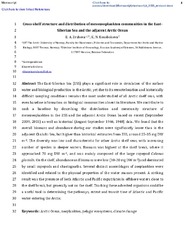Cross-shelf structure and distribution of mesozooplankton communities in the East-Siberian Sea and the adjacent Arctic Ocean
Permanent link
https://hdl.handle.net/10037/17268Date
2019-06-29Type
Journal articleTidsskriftartikkel
Peer reviewed
Abstract
The East-Siberian Sea (ESS) plays a significant role in circulation of surface water and biological production in the Arctic, yet due to its remote location and historically difficult sampling conditions remains the most understudied of all Arctic shelf seas, with even baseline information on biological communities absent in literature. We aim to fill this gap by describing the distribution and community structure of mesozooplankton in the ESS and the adjacent Arctic Ocean based on recent (September 2009, 2015) as well as historical (August–September 1946, 1948) observations. We found that the overall biomass and abundance during our studies were significantly lower than in the adjacent Chukchi Sea, but higher than historical estimates from the ESS, around 25–35 mg DW m−3. The diversity was low and characteristic for other Arctic shelf seas, with increasing number of species in deeper waters. Biomass was highest at the shelf break, where it approached 70 mg DW m−3, and was mainly composed of the large copepod Calanus glacialis. On the shelf, abundance and biomass were low (10–20 mg DW m−3) and was dominated by small copepods and chaetognaths. Several distinct assemblages of zooplankton were identified and related to the physical properties of the water masses present. A striking result was the presence of both Atlantic and Pacific expatriates in offshore waters close to the shelf break, but generally not on the shelf itself. Tracking these advected organisms could be a useful tool in determining the pathways, extent, and transit time of Atlantic and Pacific water entering the Arctic.
Publisher
Springer NatureCitation
Ershova, E., Kosobokova, K.N.(2019) Cross-shelf structure and distribution of mesozooplankton communities in the East-Siberian Sea and the adjacent Arctic Ocean. Polar Biology, 42, (7), 1353-1367.Metadata
Show full item recordCollections
Springer


 English
English norsk
norsk